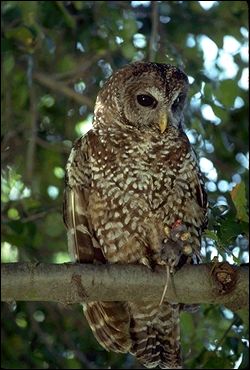

Are you for the birds? More specifically, are you for the Mexican Spotted Owl? Listed in the United States as threatened, it's a focus of controversy over national forest use. Ranging from Colorado into Mexico, over 90% of its U.S. habitat is within national forest land. It requires steep canyon slopes with the dense, multistory canopy cover of old growth forest—forest also prized for lumber.
Relying on a diet mainly of rodents, cattle overgrazing reduces its
food base, and sufficient food is required for owl breeding. With rodents normally
becoming scarce during dry seasons, overgrazing becomes critical. A federal judge
recently closed Forest Service land in Arizona and New Mexico pending solution of
overgrazing problems. The Federal Government has unveiled a new management plan that
drops requirements for monitoring endangered species and eliminates environmental
impact statements when revising forest plans. The battle will continue over public land
usage in the Southwest. The only direct voice the Mexican Spotted Owl has is a simple,
nocturnal, four-note hoot telling us it's there—and, perhaps, please
don't ignore.

Contributor: Eric A. Trum, Student, University of Texas at El Paso.
Desert Diary is a joint production of the Centennial Museum and KTEP National Public Radio at the University of Texas at El Paso.

Spotted Owl (Strix occidentalis). Image courtesy of Gerald and Buff Corsi
© California Academy of Sciences. ![]()
Deming, C. 2002. Bush Administration to ease forest management rules. Reuters.